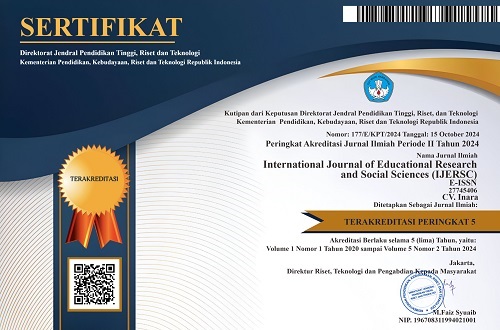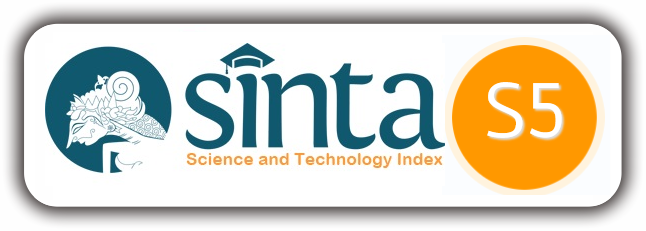Types of Assessments Based on Bloom’s Taxonomy in the Merdeka Curriculum Book English for Change for Phase F of XI Class
Abstract
This study investigates the types of assessments presented in the Merdeka Curriculum English textbook English for Change for Phase F (Grade XI), using Bloom’s Taxonomy as the analytical framework. As textbooks play a central role in translating curriculum goals into classroom practice, it is critical to examine whether their assessments promote a balanced range of cognitive skills. A qualitative content analysis was conducted to identify and categorize 74 assessment tasks according to the six levels of Bloom’s revised taxonomy: Remembering, Understanding, Applying, Analyzing, Evaluating, and Creating. The findings show that while the textbook incorporates both lower-order and higher-order thinking skills, a greater emphasis is placed on the former—particularly Understanding and Applying. Tasks requiring critical thinking and creativity (Evaluating and Creating) are included but appear less frequently. These results suggest that while the textbook aligns broadly with the Merdeka Curriculum’s competency-based philosophy, enhancements could be made to deepen cognitive engagement. Implications are discussed for teachers, curriculum developers, and researchers seeking to improve the design and implementation of assessments in EFL contexts.
Downloads
References
Brown, H. D. (2019). PF ÌINCIPLES AND CL ASSROOM PRACTK : es T > Pearson. Brown, H. Douglas, 1–395.
Fathurrahman, F., Irawan, A. ., & Fridayanti, sri . (2023). Effectiveness Of Regional Regulation Number 20 Of 2001 Regarding Regulation Of Street Traders And Seasonal Street Traders In Tarakan City. International Journal of Educational Research &Amp; Social Sciences, 4(3), 429–434.
Sulaiman, S., Halim Soebahar, A. ., & Mundir, M. (2023). Madrassa Diniyah Curriculum Transformation In Pesantren: A Study Of Wali Songo Mimbaan And Salafiyah Syafi’iyah Sukorejo Pesantren In Situbondo. International Journal of Educational Research &Amp; Social Sciences, 4(3), 444–453. https://doi.org/10.51601/ijersc.v4i3.659.
Mutiara Cipta, D. ., & Alvin, S. (2023). Safeguarding Personal Information: Communication Privacy Management By Gen-Z Influencers. International Journal of Educational Research &Amp; Social Sciences, 4(3), 465–471. https://doi.org/10.51601/ijersc.v4i3.653.
Mohammad Solekhan, Kunarto, & Mahmuda Pancawisma Febriharini. (2022). Forest And Land Fire Management Strategies : Prevention And Law Enforcement. International Journal of Educational Research &Amp; Social Sciences, 3(2), 567–580. https://doi.org/10.51601/ijersc.v3i2.306.
D. Yuliana Sinaga. (2022). The Effect Of Ralistic Mathematics Learning Model And Project-Based Learning Model On Problem Solving Ability And Motivation Of Students In Class V Private Sd Markus Medan Helvetia. International Journal of Educational Research &Amp; Social Sciences, 3(2), 590–600. https://doi.org/10.51601/ijersc.v3i2.268.
Nugroho, A. . (2022). Principle of Balance of Relationship Between Banks and Customers in Mudharabah Agreements. International Journal of Educational Research &Amp; Social Sciences, 3(2), 645–652. https://doi.org/10.51601/ijersc.v3i2.325.
Inbar-Lourie, O. (2008). Constructing a language assessment knowledge base: A focus on language assessment courses. In Language Testing (Vol. 25, Issue 3). https://doi.org/10.1177/0265532208090158
Jha, P. (2023). Significance of Bloom’s Taxonomy for Attainment of Program Outcome (PO) and Course Outcome (CO) in Educational Institute. Journal Homepage: Https://Ejournal. Jhamobi. Com, August.
Khora, H. M. (2021). Evaluation of English for Palestine Textbooks and English Language Examination in Light of Common European Framework of References for Languages (CEFRL). Journal of Educational and Psychological Sciences, 5(24), 152–175. https://doi.org/10.26389/AJSRP.H020221
Maharani, S., Fauzia, A., Syafei, R., & Fatimah, S. (2018). An evaluation on the instructions in the English Textbook for 10th grade students entilted Bahasa Inggreis published by Ministry of Education and Culture of Indonesia. E-Journal of English Language and Literature, 7(3), 520–530. http://ejournal.unp.ac.id/index.php/jell
Mithans, M., & Ivanuš Grmek, M. (2020). The Use of Textbooks in the Teaching-Learning Process. New Horizons in Subject-Specific Education: Research Aspects of Subject-Specific Didactics, July, 201–228. https://doi.org/10.18690/978-961-286-358-6.10
Momen, A., Ebrahimi, M., & Hassan, A. M. (2023). Importance and Implications of Theory of Bloom’s Taxonomy in Different Fields of Education. Lecture Notes in Networks and Systems, 573 LNNS(December 2022), 515–525. https://doi.org/10.1007/978-3-031-20429-6_47
Nooralam, J., & Sakhiyya, Z. (2022). Formative Assessment in the Merdeka Curriculum English Textbook entitled English for Nusantara. English Education Journal, 12(4), 600–610. https://doi.org/10.15294/eej.v12i4.65398
Richards, J. (2015). The Role of Textbooks in a Language Program The Role of Textbooks in a Language Program. ThRichards, J. (2015). The Role of Textbooks in a Language Program The Role of Textbooks in a Language Program. The Role of Textbooks in a Language Program, June, 1.e Role of Textbooks in a Language Program, June, 1.
Sadora, E., Faridi, A., & Suwandi, S. (2021). Formative Assessment Based on Revised Bloom’s Taxonomy in Merdeka Curriculum English Textbook. The Journal of Educational Development, 9(2), 139–148. http://journal.unnes.ac.id/sju/index.php/jed
Shadri, R., Hermita, N., Deswarni, D., Purnamasari, A. S., Julia Lingga, L., Wijaya, H., Curriculum Halaman, M., Wijoyo, H., & Guru Penggerak Provinsi Riau, B. (2023). Assessment in the Merdeka Curriculum: How Are the Teachers’ Perspectives on It? Penilaian Dalam Kurikulum Merdeka: Bagaimana Perspektif Guru Dalam Pelaksanaannya? Jurnal PAJAR (Pendidikan Dan Pengajaran), 7(1), 202–209. http://dx.doi.org/10.33578/pjr.v7i1.9127.
Shadri, R., Hermita, N., Deswarni, D., S, A. P., Lingga, L. J., & Wijoyo, H. (2023). Assessment in the Merdeka Curriculum: How Are the Teachers’ Perspectives on It? JURNAL PAJAR (Pendidikan Dan Pengajaran), 7(1), 202. https://doi.org/10.33578/pjr.v7i1.9127
Stevani, M., & Tarigan, K. E. (2022). Evaluating English Textbooks by Using Bloom’s Taxonomy to Analyze Reading Comprehension Question. SALEE: Study of Applied Linguistics and English Education, 4(1), 1–18. https://doi.org/10.35961/salee.v0i0.526
Wilson, L. O. (2016). Blooms Taxonomy Revised - Understanding the New Version of Bloom’s Taxonomy. A Taxonomy for Learning, Teaching, and Assessing: A Revision of Bloom’s Taxonomy of Educational Objectives, 1(1), 1–8.
Downloads
Published
How to Cite
Issue
Section
License
Copyright (c) 2025 International Journal of Educational Research & Social Sciences

This work is licensed under a Creative Commons Attribution 4.0 International License.






















